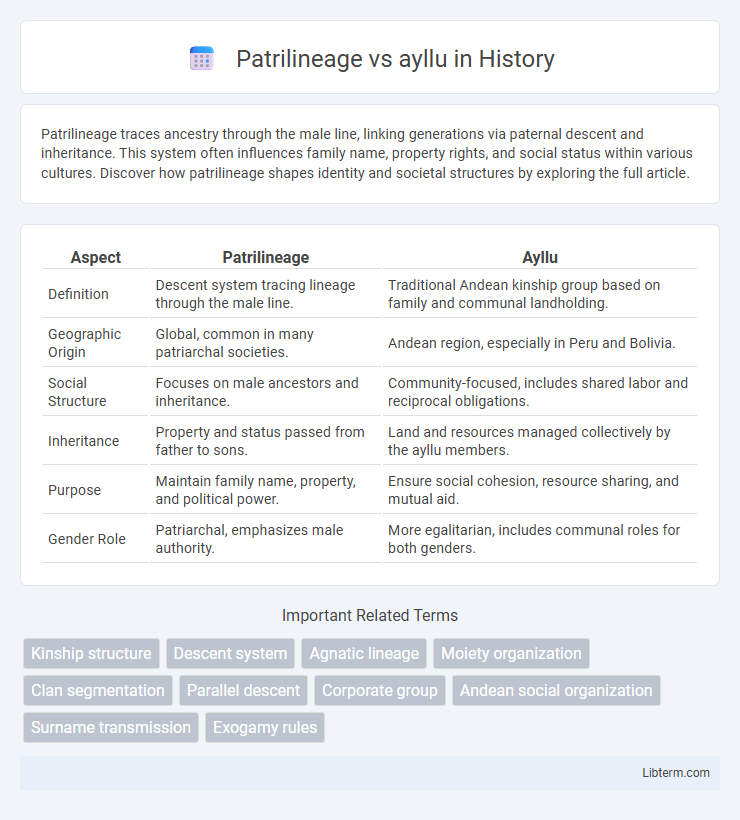Patrilineage traces ancestry through the male line, linking generations via paternal descent and inheritance. This system often influences family name, property rights, and social status within various cultures. Discover how patrilineage shapes identity and societal structures by exploring the full article.
Table of Comparison
| Aspect | Patrilineage | Ayllu |
|---|---|---|
| Definition | Descent system tracing lineage through the male line. | Traditional Andean kinship group based on family and communal landholding. |
| Geographic Origin | Global, common in many patriarchal societies. | Andean region, especially in Peru and Bolivia. |
| Social Structure | Focuses on male ancestors and inheritance. | Community-focused, includes shared labor and reciprocal obligations. |
| Inheritance | Property and status passed from father to sons. | Land and resources managed collectively by the ayllu members. |
| Purpose | Maintain family name, property, and political power. | Ensure social cohesion, resource sharing, and mutual aid. |
| Gender Role | Patriarchal, emphasizes male authority. | More egalitarian, includes communal roles for both genders. |
Introduction to Patrilineage and Ayllu
Patrilineage refers to a kinship system where descent and inheritance are traced exclusively through the male line, often emphasizing paternal ancestry in social organization and identity. The ayllu, a traditional Andean community structure, integrates extended family groups based on shared land, ancestry, and mutual aid, frequently encompassing both patrilineal and matrilineal elements. Understanding patrilineage highlights inherited paternal ties, whereas the ayllu embodies a broader, reciprocal kinship network central to indigenous Andean life.
Historical Origins of Patrilineage
Patrilineage traces descent through the male line, originating in ancient patriarchal societies where inheritance and social status passed from father to son. This system polarized lineage and property ownership, contrasting with the Andean ayllu, a communal kinship group structured around extended family ties and collective land management. The historical origins of patrilineage reveal a focus on male dominance in lineage continuity, differing fundamentally from the ayllu's inclusive, community-centric organization.
Foundations of the Ayllu System
The ayllu system is grounded in collective land ownership and kinship, emphasizing communal labor and resource sharing among extended families, unlike patrilineage, which traces descent strictly through the male line for inheritance and social identity. Foundations of the ayllu integrate ecological adaptation, reciprocity, and social cohesion, creating a flexible and cooperative community structure that transcends simple genealogical ties. This system supports sustainable agriculture and social welfare by balancing individual and group responsibilities within Andean societies.
Social Structure of Patrilineage
The social structure of patrilineage centers on descent traced exclusively through the male line, forming the foundation for inheritance, residence, and political authority within communities. Patrilineal groups typically emphasize male kinship bonds, where lineage identity influences roles, responsibilities, and social status, reinforcing hierarchical arrangements based on paternal ancestry. This contrasts with ayllu systems, which integrate extended family groups in communal landholding and cooperative labor, often incorporating bilateral or cognatic descent beyond strict patrilineal lines.
Communal Organization in Ayllu
The ayllu represents a fundamental communal organization in Andean societies, emphasizing collective land ownership, shared labor, and reciprocal relationships among members, in contrast to the patrilineage system which prioritizes descent through the male line. In an ayllu, social structure is organized around kinship ties that include both paternal and maternal lines, fostering cooperation for agriculture, resource management, and cultural rituals. This communal framework supports sustainable living and reinforces social cohesion, differing from the patrilineage's focus on hierarchical inheritance and individual lineage claims.
Kinship and Inheritance Patterns
Patrilineage emphasizes descent and inheritance through the male line, where property, titles, and family name pass from father to sons, reinforcing male dominance in kinship structures. The ayllu, a traditional Andean kinship group, integrates both patrilineal and matrilineal elements, emphasizing communal land ownership and collective responsibility rather than individual inheritance. Inheritance patterns in ayllus prioritize the redistribution of resources within the kin group to ensure social cohesion and mutual support, contrasting with the typically exclusive, male-centered transmission in patrilineal systems.
Roles and Responsibilities in Patrilineage
In patrilineage systems, roles and responsibilities predominantly revolve around male lineage, where inheritance, family name, and property pass through the father's line. Men typically hold authority in decision-making, resource management, and maintaining family honor, while women's roles often center on domestic duties and childbearing. This contrasts with the ayllu, a communal Andean system emphasizing collective responsibility, shared land, and mutual support regardless of strict lineage descent.
Economic Functions of the Ayllu
The ayllu operates as a communal economic unit in Andean societies, characterized by collective land ownership and shared agricultural labor, which ensures resource distribution and social welfare among its members. Its economic functions include joint management of natural resources, reciprocal labor exchanges known as mink'a, and coordinated production efforts that sustain both individual families and the broader community. Unlike patrilineage systems that emphasize descent and inheritance through the male line, the ayllu integrates kinship with cooperative economic practices to maintain social cohesion and economic stability.
Cultural Significance and Identity
Patrilineage defines identity and inheritance through the male line, emphasizing lineage and family continuity in many traditional societies. The ayllu, an indigenous Andean social structure, embodies collective identity and cooperation, linking members through shared ancestry, land, and mutual responsibilities. Both systems culturally anchor individuals, shaping social roles, community cohesion, and ancestral connections within their respective contexts.
Key Differences Between Patrilineage and Ayllu
Patrilineage traces descent exclusively through the male line, emphasizing inheritance and family name continuity among male ancestors, whereas ayllu is a communal social structure rooted in Andean cultures that groups families based on kinship, shared land, and mutual aid without strict gender-based lineage. Patrilineage prioritizes individual family lineage and property rights passed from father to son, while ayllu organizes collective responsibilities, resource management, and social identity across extended kin networks regardless of paternal lineage. The key differences lie in patrilineage's focus on male descent and inheritance versus ayllu's communal, cooperative system integrating multiple lineages for social and economic support.
Patrilineage Infographic

 libterm.com
libterm.com